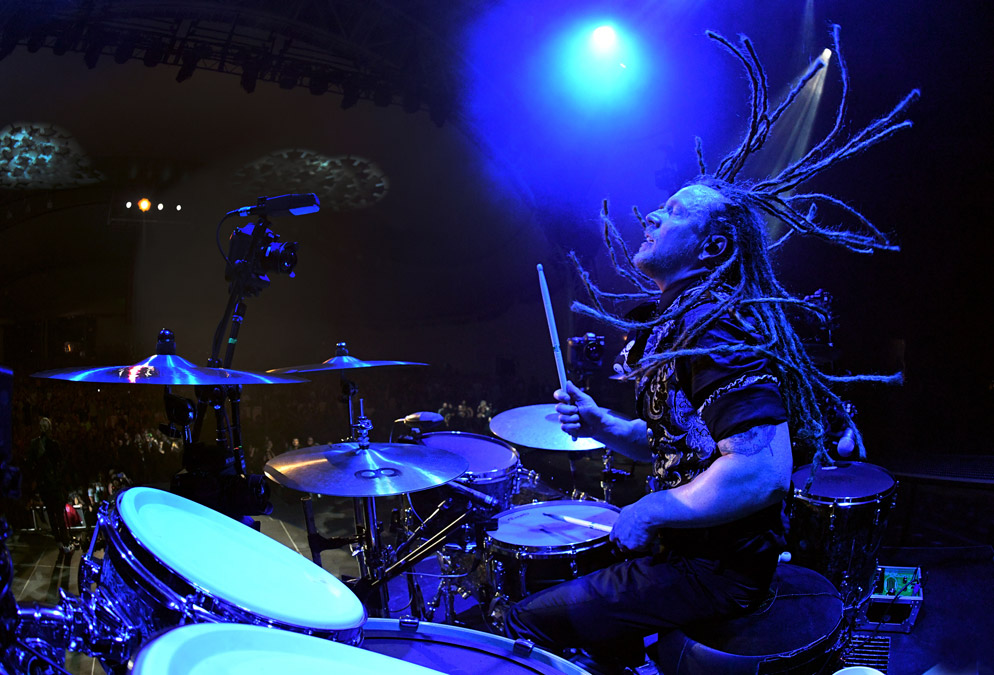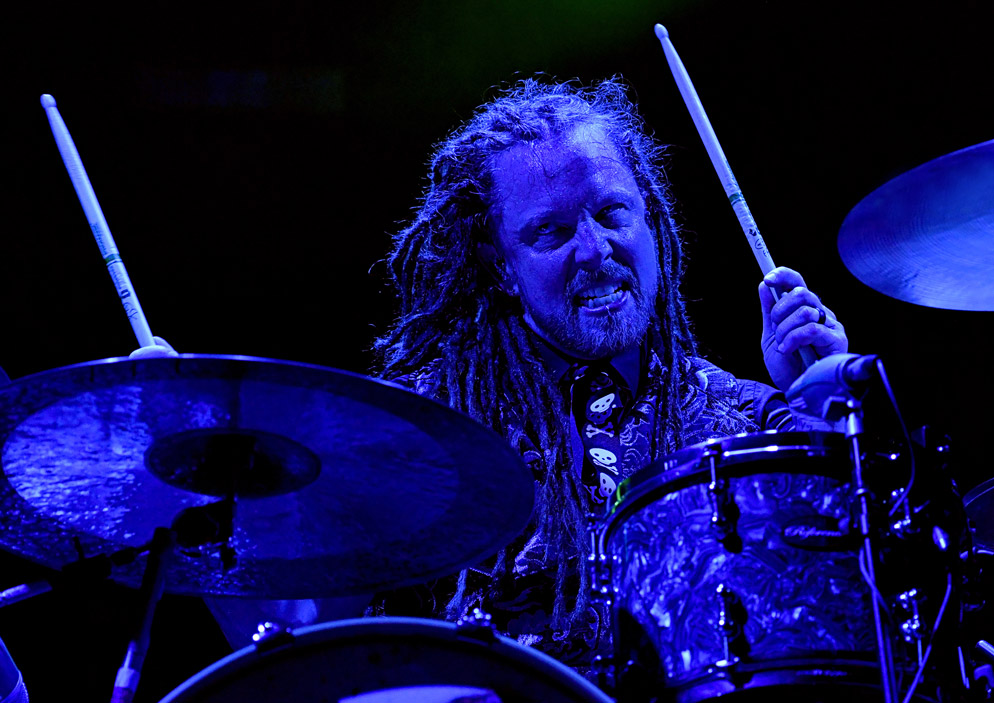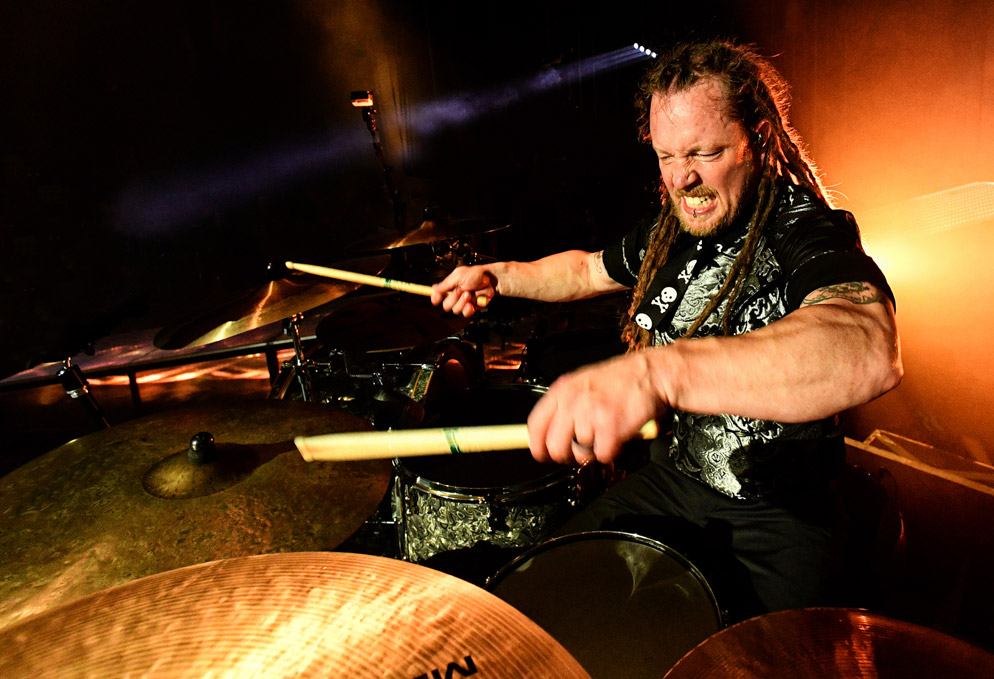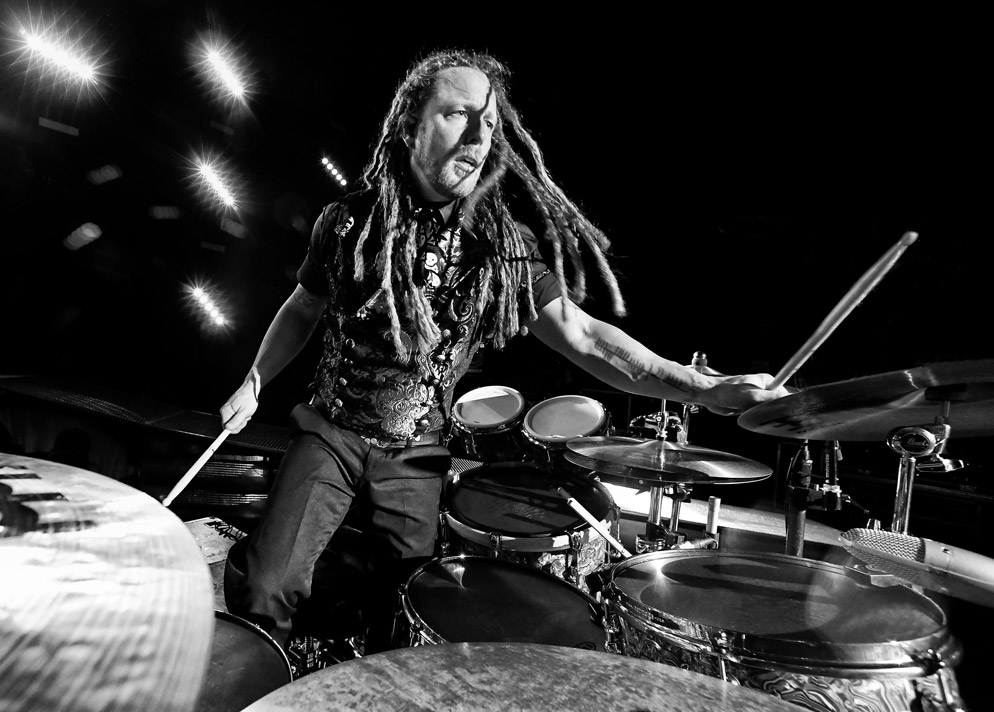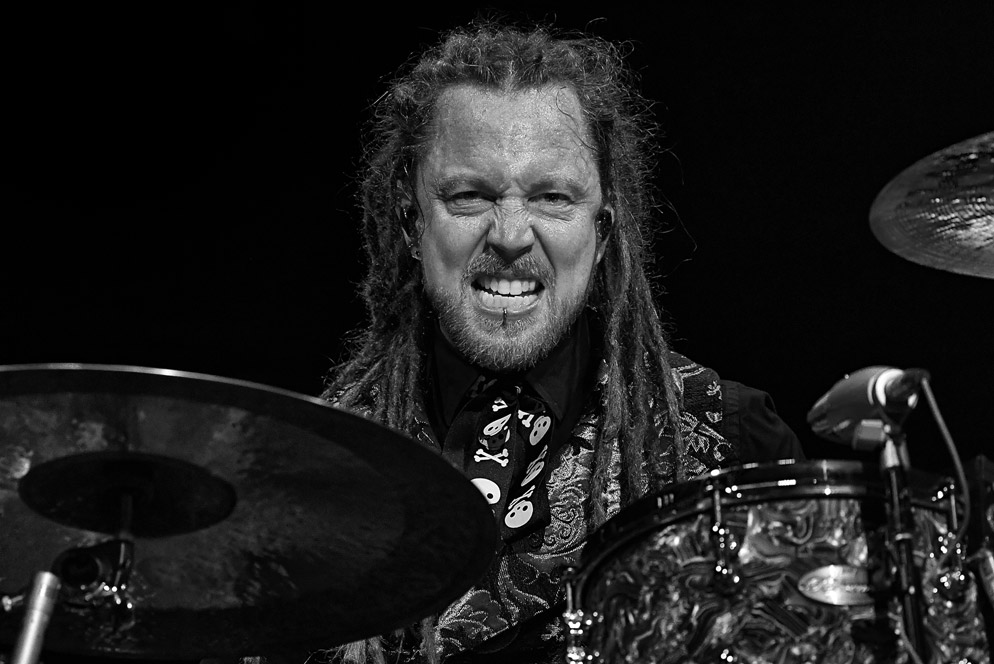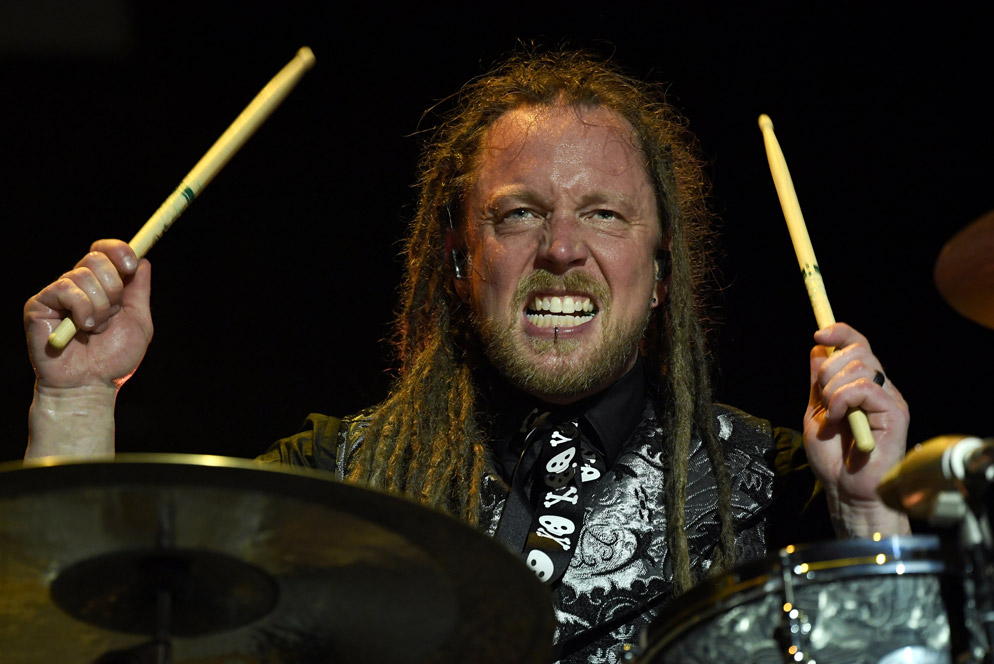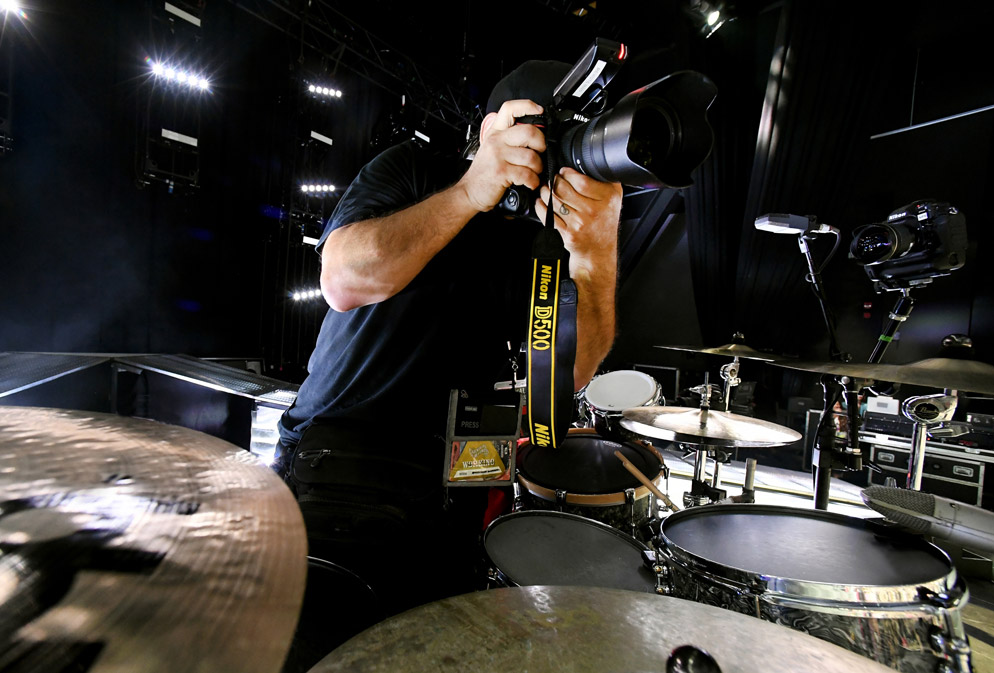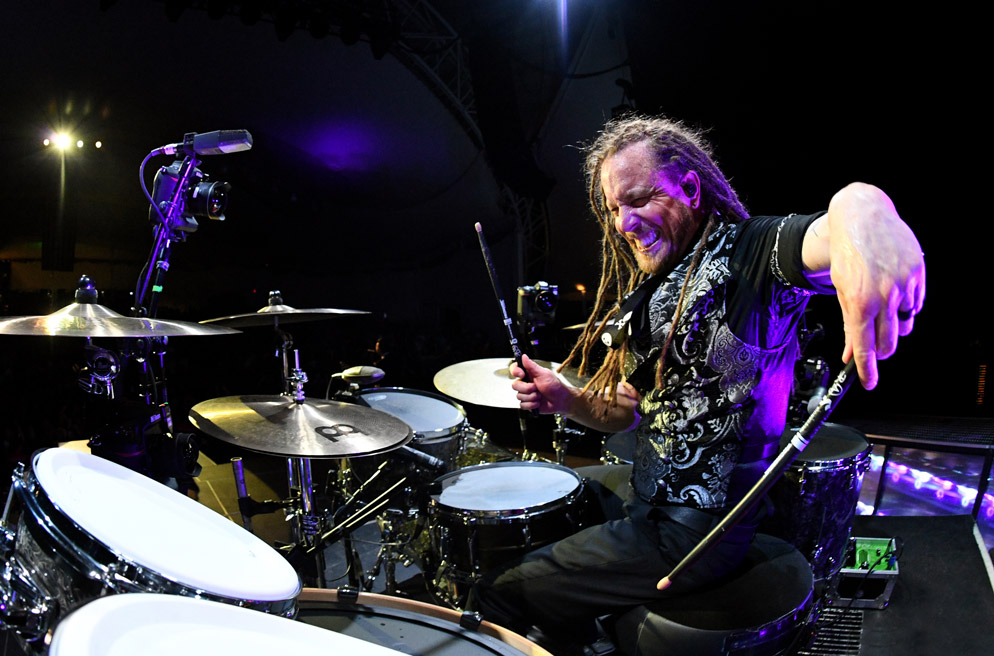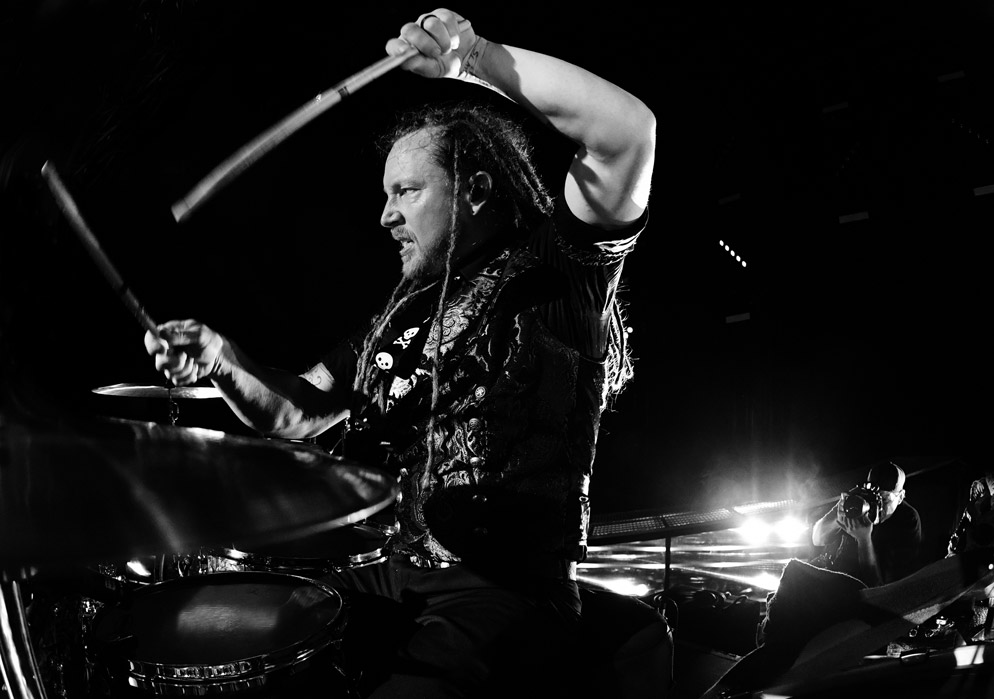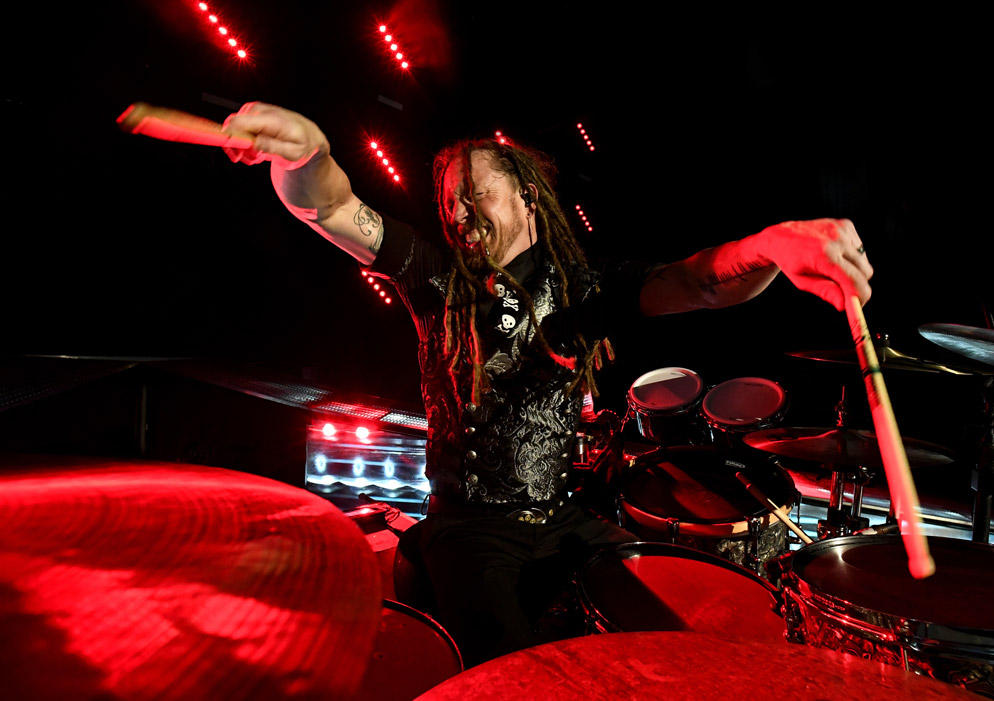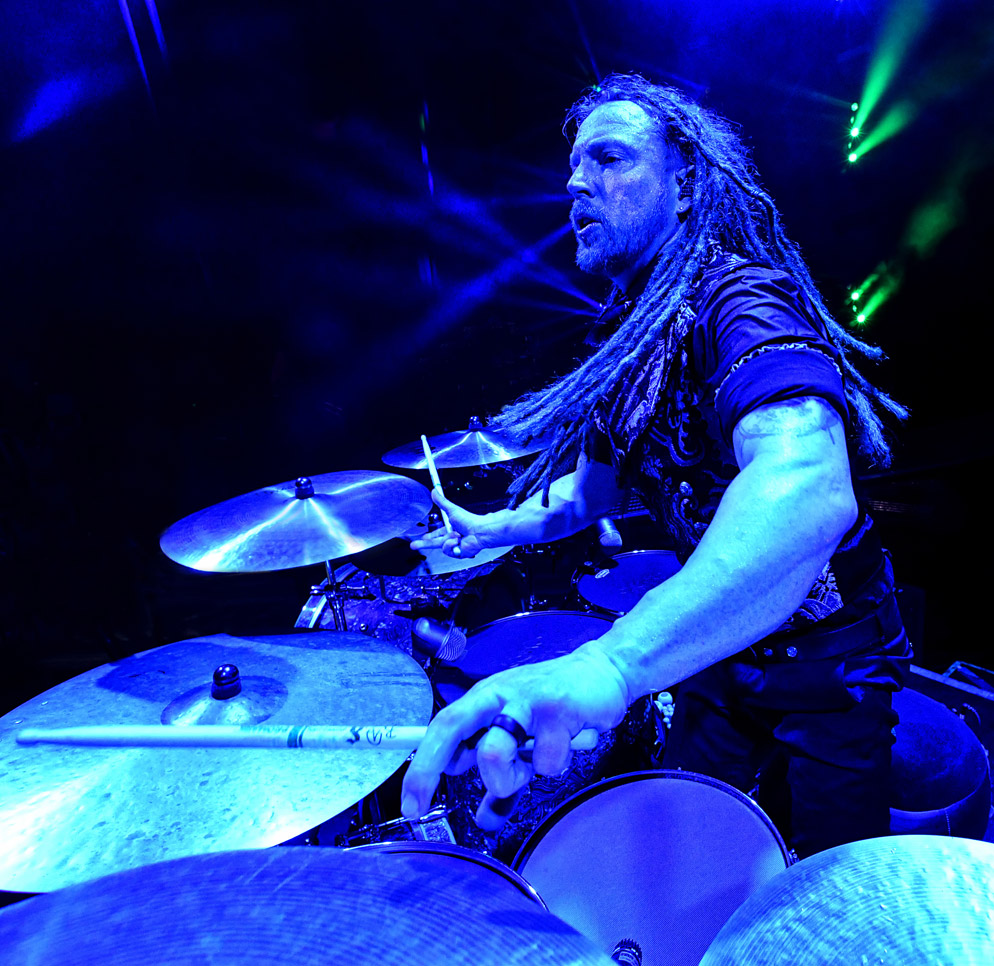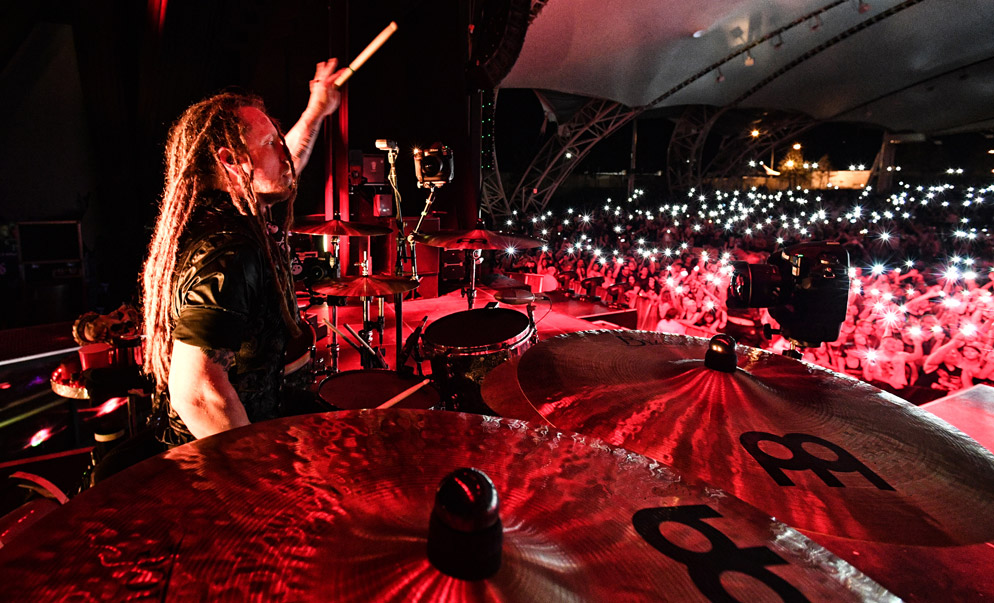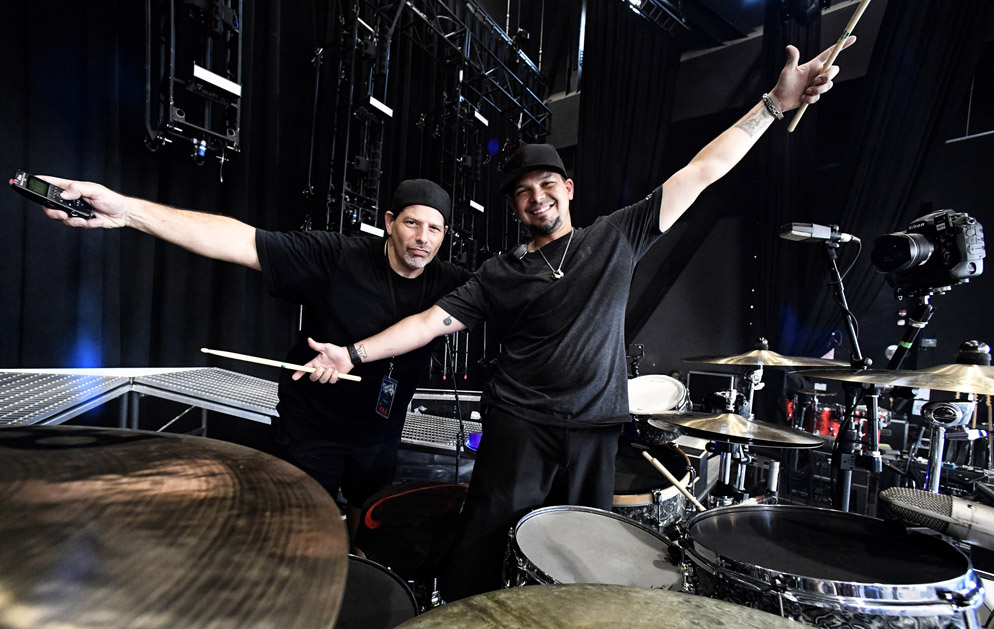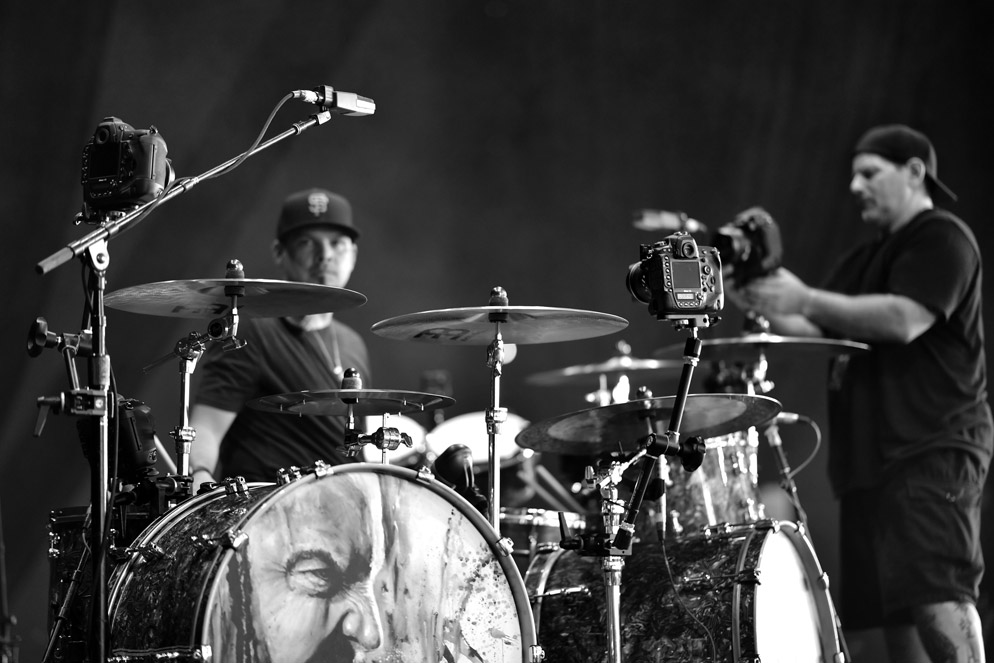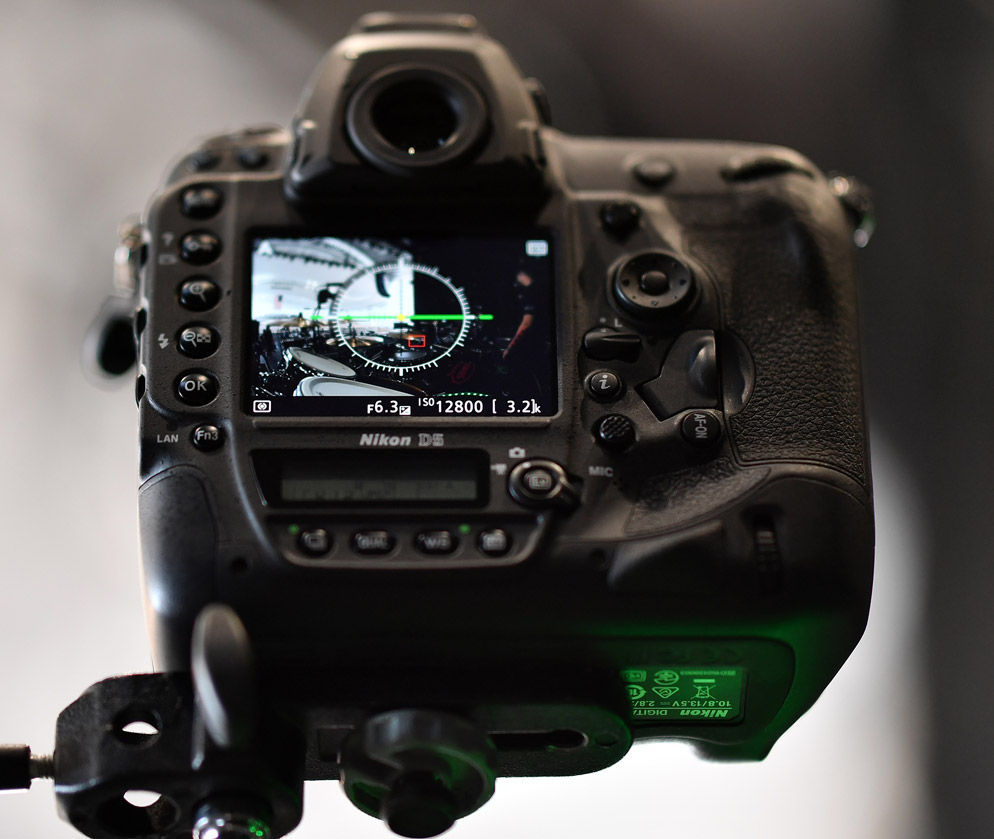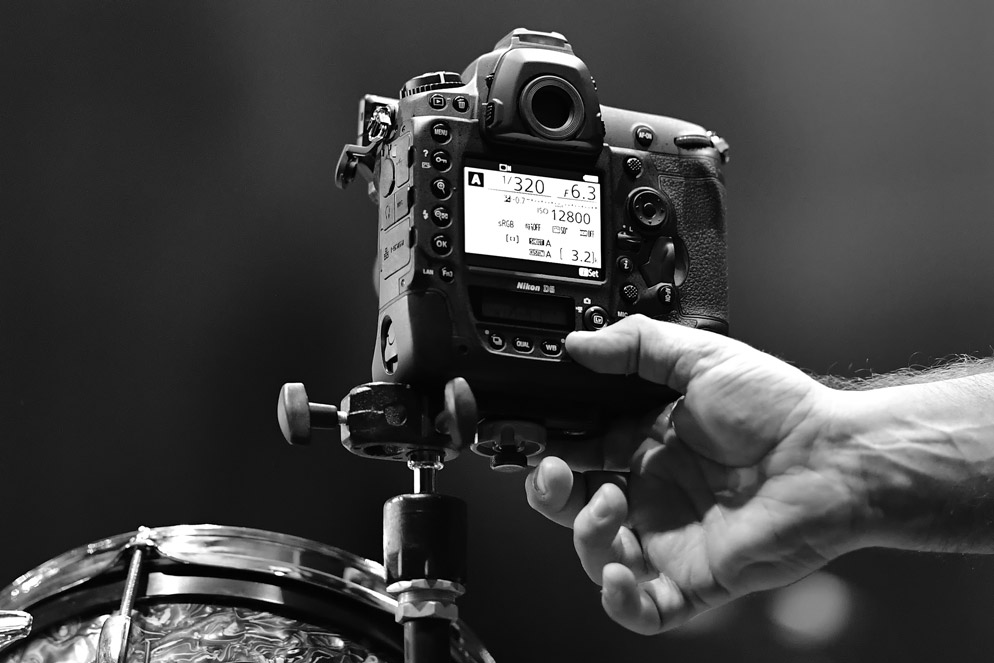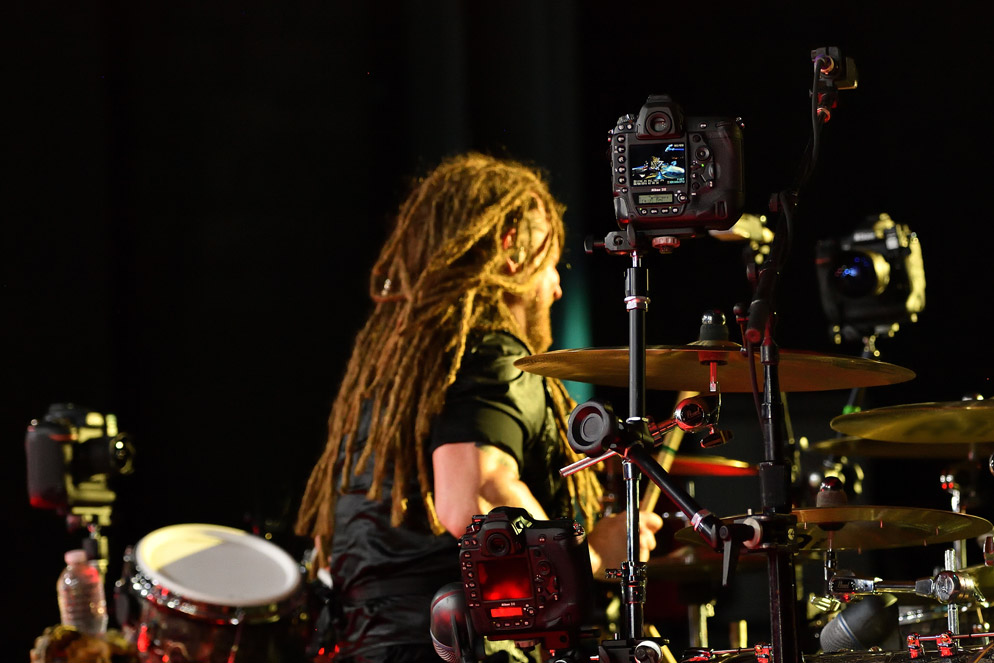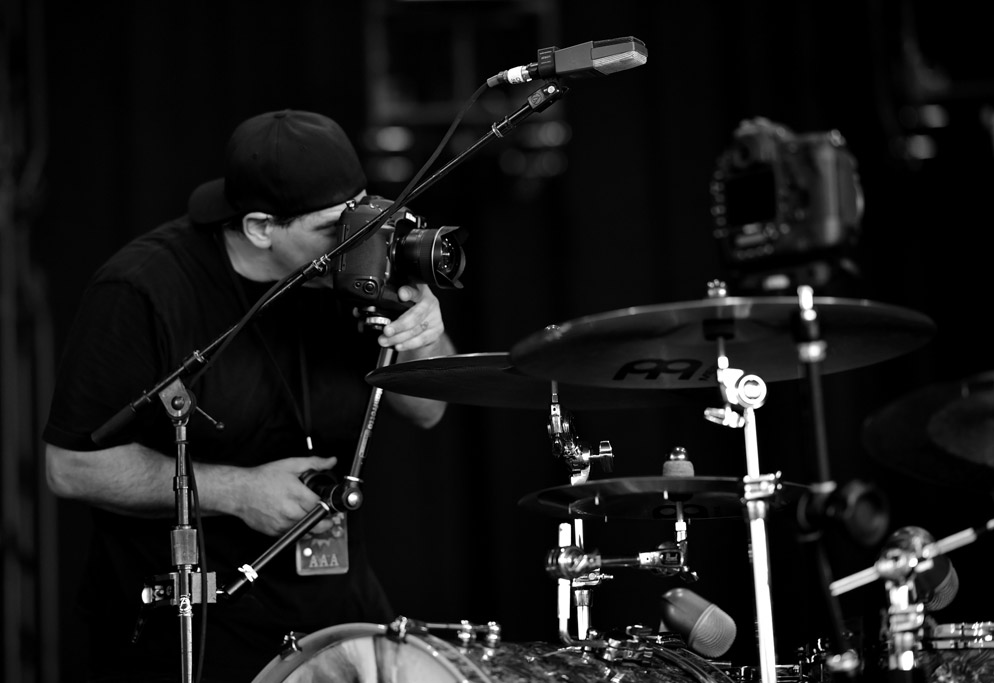Thunder Road: Remote Photography Captures the Heartbeat of Rock
If you want to do it right, here's what you shoot for: two hands, two sticks.
That's the advice Mike Corrado received when he asked Journey's drummer Steve Smith what drummers look for in a photo, and that's what Mike's aimed for during ten years of photographing rock drummers from the pit in front of the stage, or from the stage itself, or, most recently, when he places his remote cameras.
Remote photography is Mike's ultimate access, hard-earned through years of building a reputation on respect for performers, following the rules and delivering great photography.
For Mike, who is a senior manager at Nikon, remote photography is just the latest step in what he strives for in his images of drummers: in a word, more.
"Every time you go out, you learn more about how to do it," he says. "The more you learn, the more you can do, and the more you want to do. The first time I did this what I prayed for was a sharp image on the frame—that's it, and that's all. Just be sharp." But as his experience and skills grew—and imaging technology advanced—so did the possibilities of more.
Count it Down
Mike's access to bands started with local groups, small clubs, networking among contacts, world-of-mouth recommendations and making the most of every opportunity.
His main interest and the emphasis of his photography was the drummer. "Drummers are always at the back of the stage and the rear of the publicity shots," Mike says. "I never saw them getting the attention I thought they deserved. The drummer is the power of the band. He dictates the pace, and if he's off, everything's off. His beat is the beat of our hearts to the music."
Early on, as Mike was shooting a band, somebody said to him, "Make sure you show the drummer some love," and with those words, DrummerLove became simultaneously the name of his project and its purpose--to put the drummer in the spotlight, and in doing so, spotlight his ability to create dynamic images.
It was easier to sum up than accomplish. The big problem: "I couldn't get there."
"There" was the perfect position for a clear image of the drummer at the heroic moment hardly anyone sees. Mike calls it "the pilot image—you know, the fighter pilot in the cockpit, surrounded by all his stuff." From the pit or the stage, he couldn't get there consistently. "You've got cymbals, stands, maybe microphones—all kinds of hardware and obstructions blocking you from making the picture." So he took advantage of technology, and with the permission of drummers and band members, and often with the help of drum techs, he set up remote cameras.
Blood, sweat and tears later, it's paying off.
Gearing Up
Before we get to how Mike does it, let's address the obvious: because he works for Nikon, he has access to lots of gear. The thing is, though, you don't necessarily need a lot.
"The advantage of remote photography isn't in the number of frames you get," he says, "it's in how you use the technology to tell the story of whatever your passion is. One camera, maybe two, will expand your possibilities and creativity. One perfectly-placed camera blows away nineteen."
All it takes to start is one remote-capable camera with a wide-angle lens. "Get it close, head-on to the drummer, without interfering with his line of sight to the audience, and that's it."
Today Mike optimizes every opportunity by using five or six cameras positioned in and around the drum kit and remotely triggered, and two cameras with him in the pit or, if he has permission, on stage. Often he'll choose the locations for the remotes prior to or during the band's sound check, sometimes working with the drum tech as he sets the cameras in place.
"I have to get a look at the drum kit when I'm shooting a band for the first time," Mike says. "Sometimes I get that look online, sometimes it's when I show up at the venue. If there's a framework for the cymbals instead of stands, that's gold—I can use clamps on the frame instead of on cymbal or microphone stands. The thing I have to avoid is blocking the drummer from the audience—he's hard enough to see as it is. It's like putting a puzzle together when I work with a drummer's kit for the first time."
For the photos accompanying this story, here's what came into play: D5 and D500 cameras; four NIKKOR lenses (14mm f/2.8, 16mm Fisheye, 24-70mm f/2.8, 200-500mm f/5.6); WR-1 transceivers, WR-R10 receivers and WR-A10 adapters; Manfrotto Magic arms, ball heads and Super Clamps; and countless zip ties.
"Zip ties are my best friends," Mike says. "I trust the clamps, but I use the ties to back them up just in case something loosens from vibrations. Stuff is getting hit all around the cameras, and I can't have a camera fall into the kit or drop to the stage—that'll be the last time I'm allowed to work with that band."
Showtime
When the show starts, Mike might be on the stage or in the pit at the front. The two cameras he's carrying will be fitted with WR-1 transceivers that send signals to all the remote cameras, which are fitted with WR-A10 adapters and WR-R10 receivers. Every time Mike triggers one of his carry cameras, all the remotes fire.
The lenses on the remotes have been manually focused according to their distance from the drummer, with f/stops (usually in the f/5 to f/7 range) chosen to provide some depth-of-field wriggle room. The remote cameras are set for aperture priority, center-weighted metering (most of the time) and -2/3 exposure compensation ("to avoid any areas of the frame that might blow out the highlights"). Mike likes to shoot RAW files so he can make adjustments if the exposures need a little help.
Positioning the cameras starts with logic and common sense—simply, where are the best places to view the drummer?—but it's been refined and adjusted over time by knowing the drummer and the band's set. Where does he turn? Where does he look? Does he stand up? How high does he lift his arms? How are the lights going to hit him?
To get the kind of privileged access Mike often enjoys, the drummer has to trust him. "He has to know it'll be safe," Mike says. "That the cameras won't interfere, and the results will be worth it: high resolution, high quality, high concept. He has to know that I'm going to produce images that will be as close as possible to putting the viewer right there with him, so his role in the band will be seen as well as heard. Frankly, he has to know I'm going to make him look good. The way I see it, my job, my responsibility, is to make the artists look amazing. If I do that, I'll be asked back."
The drummer in these photos, Barry Kerch, of Shinedown, has that kind of faith. "About seven years ago I'm at a show, setting up for another band," Mike says, "and Barry shows up ahead of Shinedown's sound check. He sees me setting up a D300S, and he says, 'Are you going to shoot a movie with that?' I say, 'How do you know I can shoot movies with this?' and he says he owns a D300S. We get to talking, and later on I send him photos I'd made of another drummer, with a note: 'Would you ever be interested in doing this?' You can guess his answer."
The Mind Game
"Ninety percent of this game is half mental," Yogi Berra said of baseball. His observation is true of photography as well. You need a purpose, a plan, a system, lots of patience and a tolerance for disappointment and frustration. There's trial and error until you lock down the procedure, and even then there's error.
"You have to stay focused, and I'm not talking about the camera lens," Mike says. "You have to be aware of everything that's going on as you're setting up. A momentary lapse and a camera isn't turned on and won't fire for the whole show—and of course it's the camera that's covering a precise, important angle."
Or a camera can be bumped after you set it up, and there's no way you can know that, so you end up with 5,000 out-of-focus pictures. "That's happened," Mike says.
But what happens more often are photographs like the ones you see here: the moments, the looks, the energy, all in hero images. "I know the set list," Mike says. "I know when the drummer's going to hit hard and when he's going to lay out. I know when the lights will change, when the pyrotechnic display will go off."
He knows one other thing: the importance of the drum tech. For Shinedown, that's Mark Bennett, and his cooperation, patience and expertise played a part in every picture you see here.
Sometimes there's the unexpected—something cool that happens just when he starts thinking he can't do anything that's different or unusual. "I'll get a slightly blurred photograph," Mike explains, "but it's a revealing blur that captures more than any frozen split-second, because in that moment of movement you see the drummer's style, his expression, his emotion. It's something new, something more, and I got it."
There's much he has to be aware of before, during and after the show, but there's one commitment to honor above all. "You have to show respect for the band, the drum tech, the road manager, the tour manager, everyone. You show that you're a professional, just as they are, and with respect and professionalism you build a reputation."
And then you give something more. "I'll send photo files to the drummers, and sometimes a band's manager or agent will ask for photos for their use. I always give those, too. All I ask is that the band make a donation to a charity—most often to Ronald McDonald house. "We're all gifted to be able to do what we do, and we have to give something in return."

